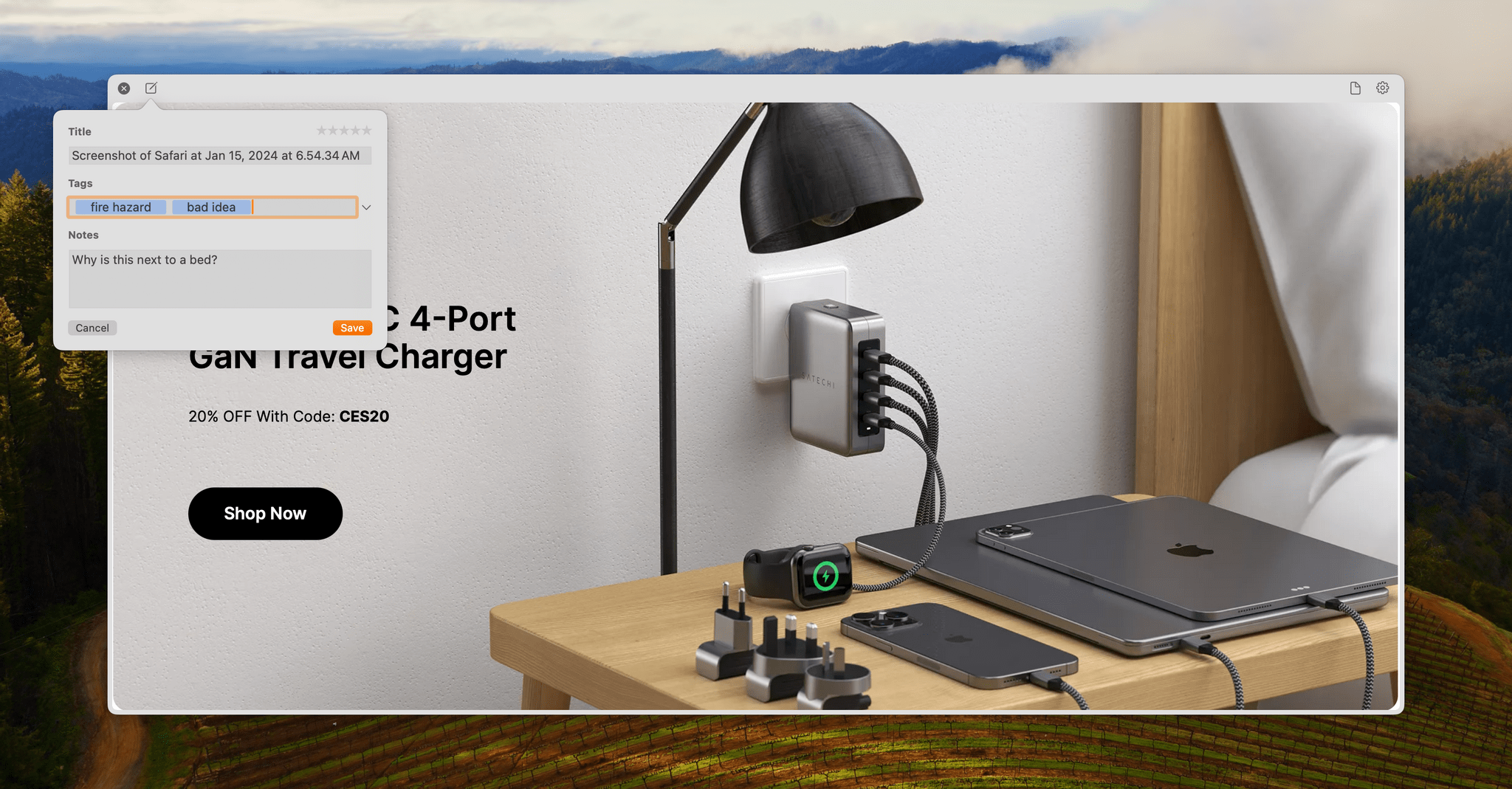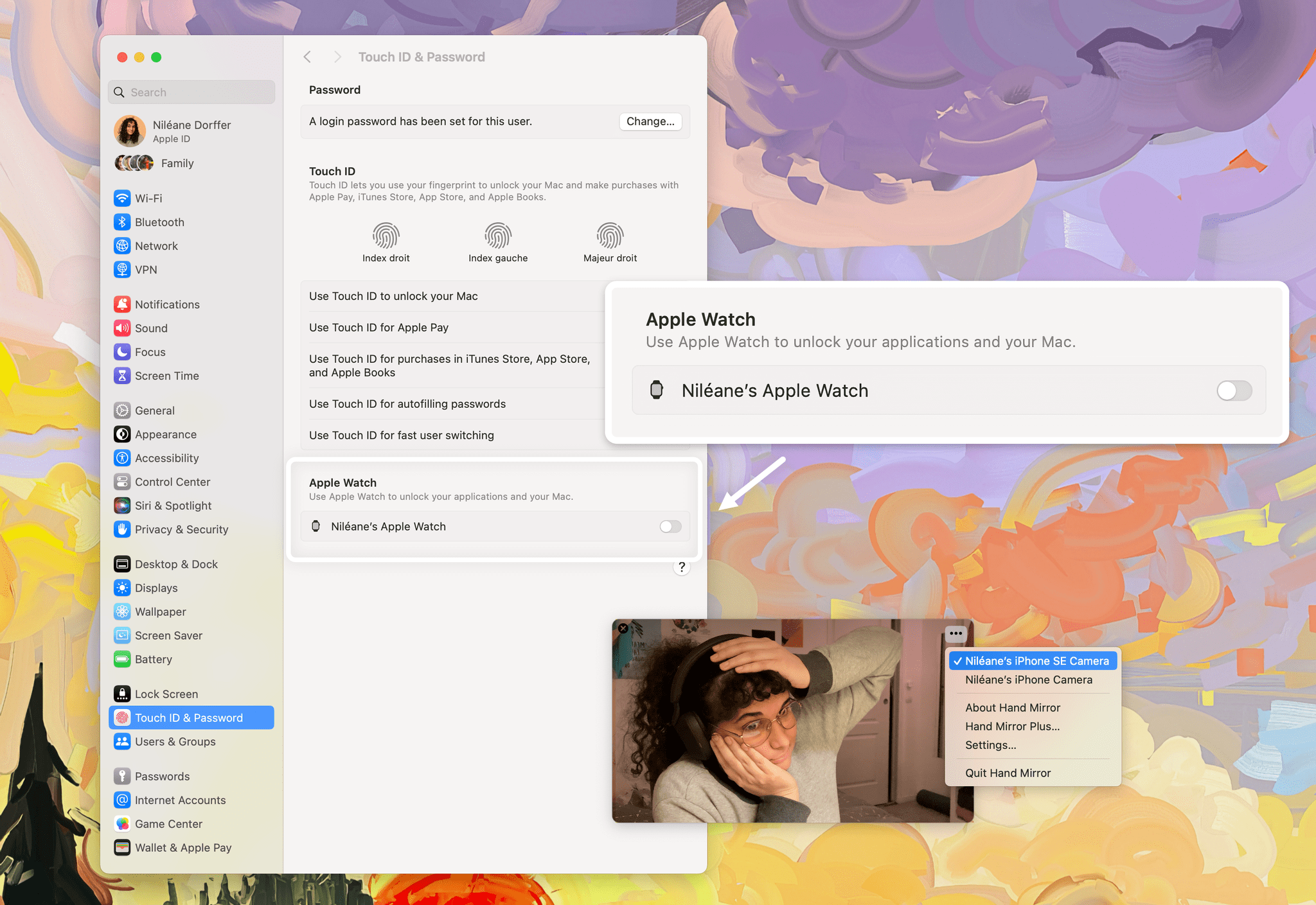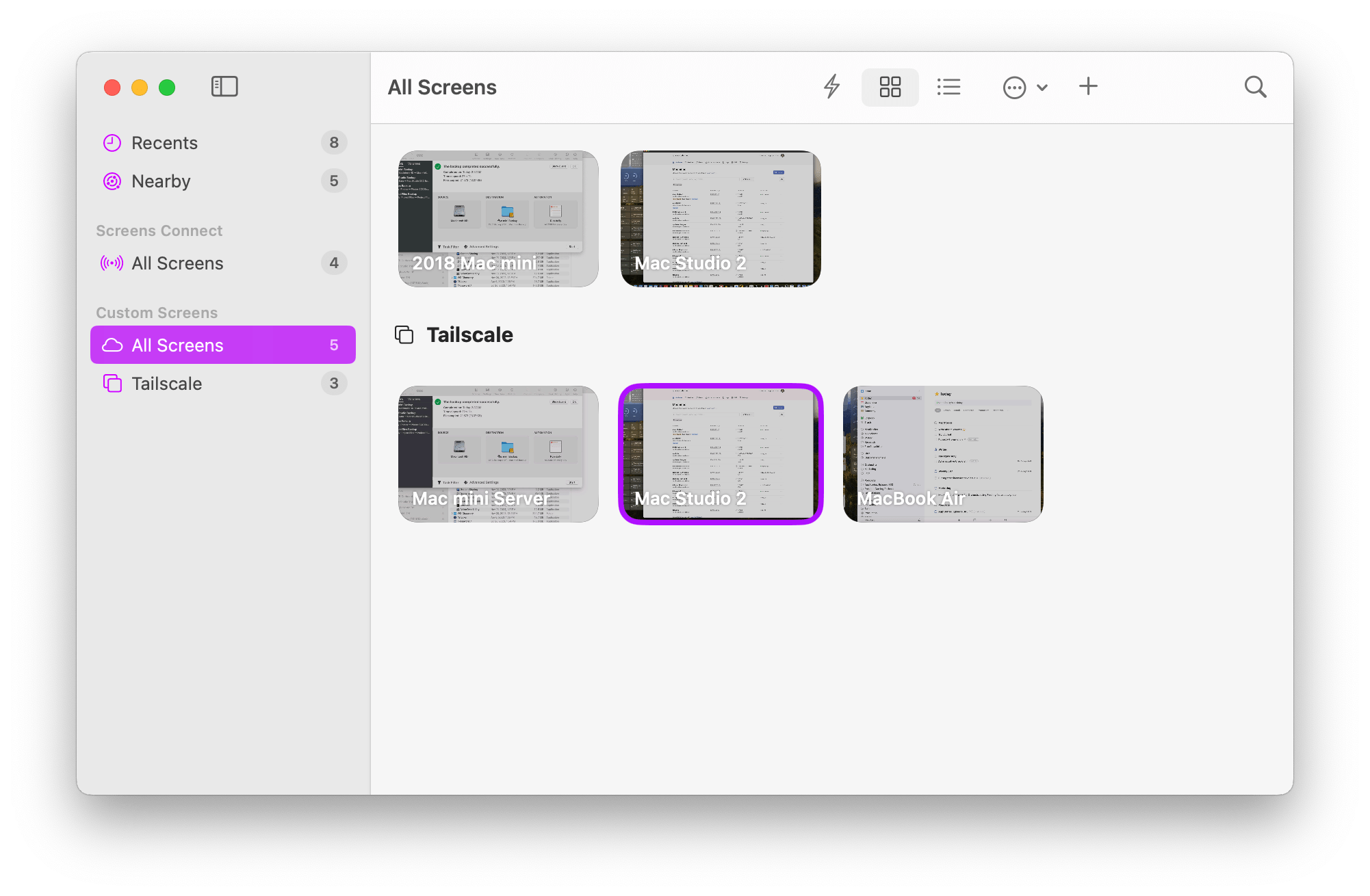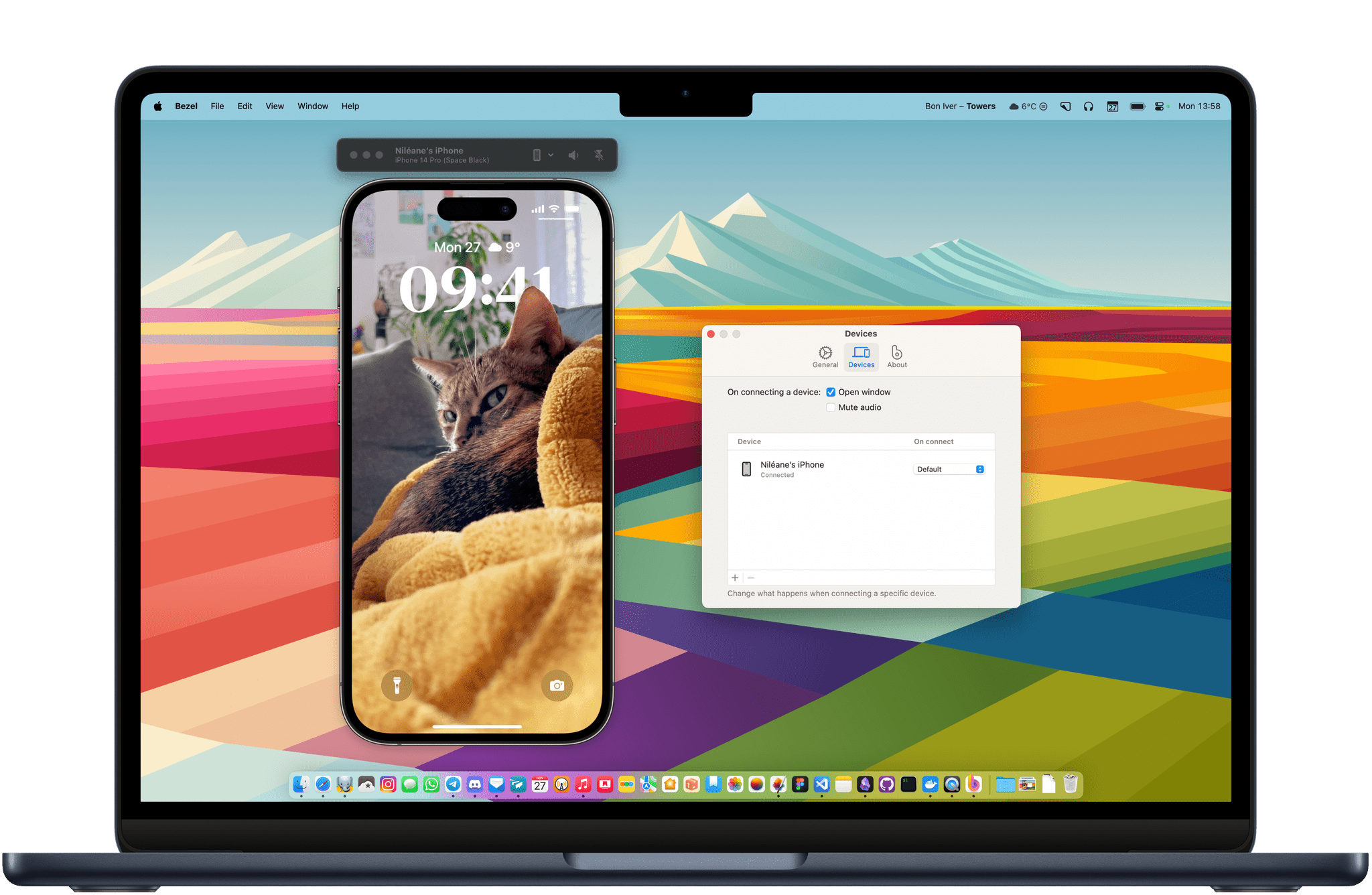ScreenFloat 2.0 is a Mac-only screenshot utility from Matthias Gansrigler of Eternal Storms Software. As Gansrigler explains, the app is like Picture-in-Picture for screenshots, allowing you to float screenshots or screen recordings above other windows to use as reference material on your Mac. That’s a great explanation of one of the core use cases for ScreenFloat 2.0, but the update opens up exciting new possibilities that go even further, which I think anyone who works with screenshots will like a lot.
Posts tagged with "macOS"
ScreenFloat 2.0: Floating Reference Screenshots and Management from the Mac’s Menu Bar
The Continuity Camera and ‘Unlock With Apple Watch’ Conspiracy
Continuity Camera is amazing. Since it was introduced in macOS Ventura, I’ve been using the feature almost daily. Continuity Camera is a native feature on macOS that lets you use an iPhone as your webcam. For it to work, you can either connect the iPhone to your Mac using a cable, or use it wirelessly if both devices are signed in with the same Apple ID. It’s quite impressive that, despite having to rely so often on video calls for work, I still don’t own a webcam today. Instead, the camera I use at my desk is an old iPhone SE (2nd generation), which was my partner’s main iPhone until they upgraded last year.
Over the past few months, however, the number of video calls I have needed to take on a daily basis has become critical. As an activist, part of my work now also involves conducting online training sessions with sometimes up to a hundred participants at a time. I just couldn’t afford to join one of those sessions and not have my camera working. Continuity Camera became a feature that I need to work reliably. Sadly, it doesn’t. Half of the time, apps like Zoom and Discord on macOS could not see the iPhone SE in the list of available cameras. This meant I had to fetch a Lightning cable to manually connect the iPhone. If I was unlucky that day, and that didn’t work, I would have to completely reboot the Mac. If I was really unlucky that day, and even that didn’t work, I would end up joining the call without a camera. Despite meeting all the requirements listed by Apple Support, this problem just kept happening on random occasions.
I had to find a fix for this bug, or at least a way to work around it.
The M3’s Potential to Transform Mac Gaming→
Raymond Wong has an excellent story on Inverse about the Mac and gaming. Wong spoke to multiple Apple representatives about its push to build Macs that can handle the most demanding PC and console games, exploring the impact of Apple silicon on the company’s efforts. In that vein, Doug Brooks, a member of the Mac product marketing team, told Inverse:
Gaming was fundamentally part of the Apple silicon design. Before a chip even exists, gaming is fundamentally incorporated during those early planning stages and then throughout development. I think, big picture, when we design our chips, we really look at building balanced systems that provide great CPU, GPU, and memory performance. Of course, [games] need powerful GPUs, but they need all of those features, and our chips are designed to deliver on that goal. If you look at the chips that go in the latest consoles, they look a lot like that with integrated CPU, GPU, and memory.
That integrated, console-like approach has the added benefit of bringing the iPhone and iPad along for the ride, greatly expanding the potential size of the market for game developers. According to Leland Martin, one of Apple’s software marketing managers:
If you look at the Mac lineup just a few years ago, there was a mix of both integrated and discrete GPUs. That can add complexity when you’re developing games. Because you have multiple different hardware permutations to consider. Today, we’ve effectively eliminated that completely with Apple silicon, creating a unified gaming platform now across iPhone, iPad, and Mac. Once a game is designed for one platform, it’s a straightforward process to bring it to the other two. We’re seeing this play out with games like Resident Evil Village that launched first [on Mac] followed by iPhone and iPad.
With the introduction of the M3 family of chips, Apple’s gaming story continues to evolve by adding hardware-accelerated ray tracing, mesh shaders, and Dynamic Caching, which determines on-the-fly the amount of memory to make available to the M3’s GPU for improved performance. Those chip enhancements are paired with new developer tools designed to make it easier to bring games to the Mac.
There are a lot of variables at play, and whether Apple can compete head-to-head with PC and console games is far from certain. However, what’s clear is that Apple is doing more than at any time in recent memory to make a run at the top end of the videogame market.
Some of the fruits of those efforts are beginning to appear on the App Store. Capcom’s Resident Evil Village debuted on the Mac in the fall of 2022 and more recently on the iPhone and iPad. As Wong notes, Lies of P, one of the top releases of the year was released on the Mac at the same time as other platforms, and Baldur’s Gate 3 was released on Steam for the Mac just a couple of months after its debut on other platforms. Plus, Capcom is back with Resident Evil 4 on every Apple device, and Death Stranding is slated for early next year. That’s a lot of top-notch games.
I’ve been playing many of these titles across an original M1 MacBook Air, M1 Max Mac Studio, and, most recently, on M3 Max MacBook Pro that Apple sent me, and the early results aren’t surprising. The M1 MacBook Air struggles, while the M3 Max MacBook Pro looks stunning. That may not make any Mac the best choice for gaming today, but with the M3, the technology to make it competitive with PCs and consoles is emerging and will inevitably trickle down to more affordable Macs over time.
Whether that happens fast enough and whether Apple can attract the biggest games are just two of many open questions. However, as we head into 2024, I’m encouraged by what I’ve seen so far and plan to share more of my ongoing exploration of Mac gaming in the new year.
MacStories Selects 2023: Recognizing the Best Apps of the Year
John: Every year, it seems like the MacStories Selects awards roll around faster than the last, and this year was no exception. For most people, the year begins on January 1st, but for us, WWDC marks the beginning of our year, and the MacStories Selects Awards feel like its conclusion. Plenty happens the rest of the year, but it’s these seven months that are the main event for us.
June begins with excitement about what developers will be able to do with Apple’s latest frameworks. Reconnecting with developers and meeting new people energizes and carries us through a busy summer and fall. This year marked Federico’s return to WWDC for the first time since the pandemic, and seeing so many developers together made this year’s WWDC the best in years.
2023 was an exciting year for apps. Read-later apps continued to be hot, but nothing was quite as big as interactive widgets, which brought new experiences to our Home and Lock Screens and shook up how many of us set up our devices.
Next year promises to be an even bigger year for apps with an all-new Vision Pro App Store on the way. For now, though, it’s time to pause and reflect on the many apps we tried in the year gone by and recognize the best among them.
Like last year, we’ve picked the best apps in seven categories:
- Best New App
- Best App Update
- Best New Feature
- Best Watch App
- Best Mac App
- Best Design
- App of the Year
But there’s more. Club MacStories members picked the winner of the MacStories Selects Readers’ Choice Award. Plus, as we’ve done the past couple of years, we’ve named a Lifetime Achievement Award winner that has stood the test of time and had an outsized impact on the world of apps. This year’s winner, which joins past winners PCalc and Drafts, is the subject of a special story I wrote for the occasion.
We also recorded a special episode of AppStories covering all the winners and runners-up. It’s a terrific way to learn more about this year’s apps.
You can listen to the episode below.
46:16
So with that, it’s my pleasure to introduce the 2023 MacStories Selects Awards to the MacStories community.
2023 MacStories Selects Awards: Lifetime Achievement Award
It’s no secret that we’re big fans of the Pixelmator Team’s image editing apps at MacStories. A lot of our coverage in recent years has focused on Pixelmator Pro and Photomator, but long before those apps ever hit the App Store, there was just plain Pixelmator, an app that’s still available on the iPhone and iPad, and I still use regularly.
Pixelmator debuted on the Mac in the fall of 2007. Here’s how the Pixelmator Team described the release on its blog:
Pixelmator Team today released Pixelmator 1.0, GPU-powered image editing tool that provides everything needed to create, edit, and enhance still images.
Built from the ground up on a combination of open source and Mac OS X technologies, Pixelmator features powerful selection, painting, retouching, navigation, and color correction tools, and layers-based image editing, GPU-powered image processing, color management, automation, and transparent HUD user interface for work with images.
It’s fun to look back at the app’s launch page with its focus on the iSight camera, iPhoto, and the latest Mac OS X technologies like Core Image and Open GL. It feels dated now, but the fundamentals that made Pixelmator an exciting new app in 2007 are just as important for the app and the Pixelmator Team’s other apps today as they were then.
Screens 5: An Updated Design, Improved User Experience, and New Business Model
Screens, the remote screen-sharing app for the iPhone, iPad, and Mac by Luc Vandal of Edovia is one of those apps that I feel like I’ve always used. It’s installed on all of my devices, letting me lazily check on the Mac in my office from my couch or grab a file that I forgot to put on my laptop when I’m working remotely. It’s also the app that makes working with my headless Mac mini server that’s humming away in a closet feel like it was sitting right on my desk.
The last time I reviewed Screens was in 2017 when version 4 was released. In the years since, the app has received regular updates, refining the workflow of connecting to remote computers and keeping up with the latest changes to Apple’s OSes. However, as an app that’s designed to be a window to another system, the UI hasn’t seen a lot of change until today’s update to version 5, which adds a bunch of refinements to how connections are organized and makes significant improvements to the app’s toolbar.
Bezel: The Best Way to Screen Capture Your iPhone From a Mac
I have recently been working on a personal web project that involves a lot of testing on my iPhone. While I would usually just have my iPhone to the side on my desk to test my changes in real-time and take screenshots, I was looking for a solution to mirror my iPhone’s screen directly on my Mac’s desktop. This is where I stumbled upon Bezel.
Bezel is a fantastic utility from Nonstrict that allows you to start capturing your iPhone immediately after connecting it to your Mac. The app is both simple and extremely convenient.
To start using Bezel, all you need to do is allow the app to start at login. Then, plug in your iPhone when you want to start mirroring your screen. That’s it. Bezel will automatically display your iPhone on your desktop. Similar to Federico’s Apple Frames shortcut, the app will frame your iPhone’s display with a bezel that matches your iPhone model.
Apple Marks International Day of Persons with Disabilities with Video and Ebook
Sunday, December 3rd is International Day of Persons with Disabilities, and to mark the day, Apple has released a short film directed by Taika Waititi. The film, shot in New Zealand, stars a young girl and a menagerie of fanciful creatures searching for one of their voices. The narrative is told in rhyme in a style that’s reminiscent of a children’s book, which foreshadows the final scene of the video between a father and his daughter, which I won’t spoil. The narrator is Dr. Tristram Ingham, a physician from Taika Waititi’s hometown in New Zealand who has a rare form of muscular dystrophy and uses Personal Voice to narrate the film.
The video is a touching way of promoting Personal Voice, an important new accessibility feature of iOS 17, iPadOS 17, and macOS Sonoma. Users record 15 minutes of themselves speaking, which is processed privately, on-device, creating a facsimile of their voice. It’s an invaluable feature for anyone who is at risk of losing their voice as a result of a disease or disability.
As Apple explains in its press release, the voice that is created is stored locally on the device on which it is recorded but can be stored in iCloud and shared with up to three devices. If you choose to use iCloud, voice data is end-to-end encrypted. The device on which you record your voice must be password-protected, too.
The film released today also highlights Live Speech, a feature of iOS, iPadOS, and macOS that allows users to type responses that are spoken aloud in a system-generated voice or your Personal Voice. You can learn more about setting up Personal Voice and using Live Speech from this Apple Support video on YouTube:
Alongside the video released today is a free ebook version of the story told in the video, which is designed to continue the conversation about voice loss and help people faced with losing their voices.
Apple Announces Apps of the Year
Today, Apple unveiled the winners of its annual App Store Awards in 10 categories. Earlier this month, Apple revealed almost 40 finalists across its award categories for their innovation and excellence.
As in the past, this year’s winners represent a broad cross-section of the App Store:
Apps
iPhone App of the Year: AllTrails, from AllTrails, Inc.
iPad App of the Year: Prêt-à-Makeup, from Prêt-à-Template.
Mac App of the Year: Photomator, from UAB Pixelmator Team.
Apple TV App of the Year: MUBI, from MUBI, Inc.
Apple Watch App of the Year: SmartGym, from Mateus Abras.
Games
iPhone Game of the Year: Honkai: Star Rail, from COGNOSPHERE PTE. LTD.
iPad Game of the Year: Lost in Play, from Snapbreak Games.
Mac Game of the Year: Lies of P, from NEOWIZ.
Apple Arcade Game of the Year: Hello Kitty Island Adventure, from Sunblink.
Cultural Impact
For the App Awards Cultural Impact category, Apple picked five apps and games, which the company chose for their “ability to drive positive change through apps and games:”
Pok Pok from Pok Pok
Proloquo from AssistiveWare*
Too Good To Go from Too Good To Go
Unpacking from Humble Bundle
Finding Hannah from Fein Games GmbH
As always it’s great to see some of the MacStories Team’s favorite apps on this list, including Pok Pok, Photomator, and SmartGym. Congratulations to the developers of all the winning apps and games.



















